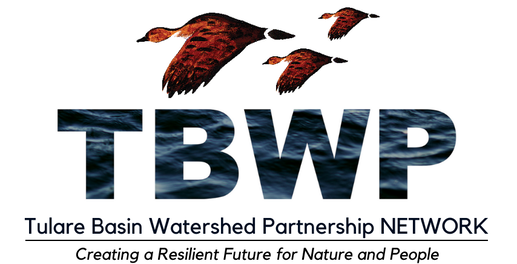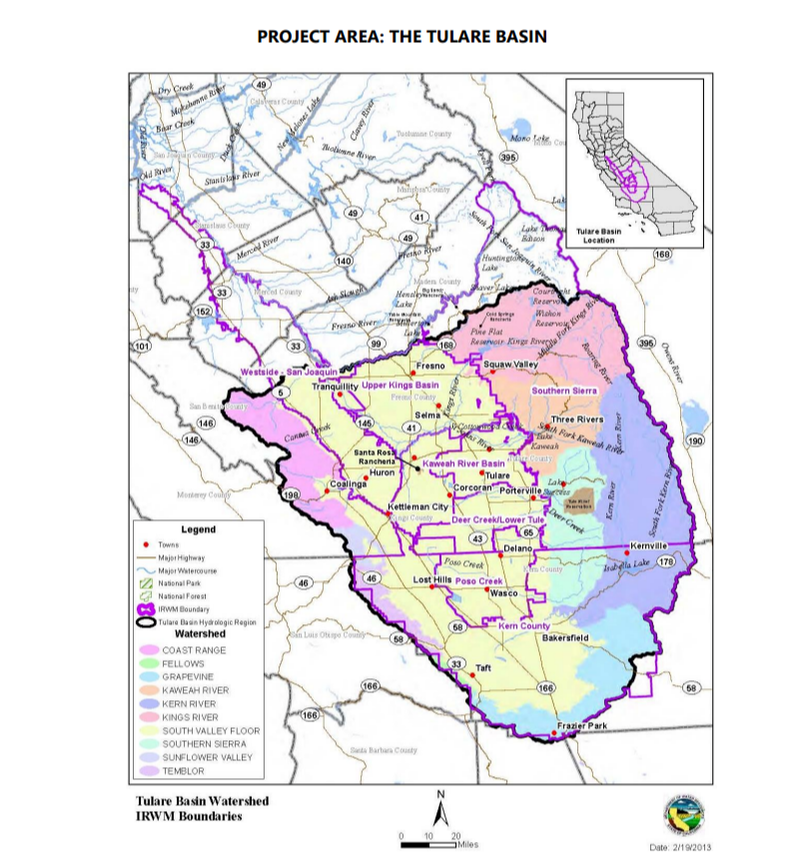
The Tulare Basin Watershed Connections Collaborative has evolved to become the Tulare Basin Watershed Partnership Network. Meeting notes and related information will be posted regularly in this space going forward.
For more information contact
[email protected]
Meeting minutes & materials for TBWPN meetings
June 11th, 2021 Tulare Basin Watershed Partnership Network Q2 meeting
1pm - 3:30pm : Meeting Minutes | Agenda
Materials:
1pm - 3:30pm : Meeting Minutes | Agenda
Materials:
- TBWPN Break-out Group Slides
March 12th, 2021 Tulare Basin Watershed Partnership Network Q1 meeting
1pm - 4:30pm : Meeting Minutes | Agenda
Materials:
1pm - 4:30pm : Meeting Minutes | Agenda
Materials:
December 11th, 2020 Tulare Basin Watershed Partnership Network 3rd meeting
1pm - 4:30pm : Meeting Minutes | Agenda
Materials:
1pm - 4:30pm : Meeting Minutes | Agenda
Materials:
September 25th, 2020 Tulare Basin Watershed Partnership Network 2nd meeting
1pm - 4:30pm : Meeting Minutes | Agenda
Materials:
1pm - 4:30pm : Meeting Minutes | Agenda
Materials:
June 26th, 2020 Tulare Basin Watershed Partnership Network Kick-off meeting
1pm - 4pm : Meeting Minutes | Agenda
1pm - 4pm : Meeting Minutes | Agenda
General Information about Water
Where does my water come from?
Groundwater is a major source - if not the only source - of drinking water for many communities within the vast Central Valley stretching from San Joaquin County to Kern County. The region also relies on water from the State Water Project, Central Valley Project and other locally financed water projects. In the small rural foothill communities above the valley floor, many homes are supplied by individual wells. (Source)
Water is commonly measured by the acre-foot. One acre foot equals 325,851 gallons. Put another way, an acre-foot of water is enough to flood a football field - which is roughly an acre in size - 1 foot deep. The average California household uses between one-half and one acre-foot of water per year for indoor and outdoor each year.
Stretching the Water Supply
Even as the available supply of water in California remains fixed, the state's increasing demand means water suppliers and water users must do all they can to squeeze the most use from each precious drop of water. This necessity becomes even more evident in years when drought conditions exist and the water supply is precariously balanced between urban, agricultural and environmental demands.
Water conservation is an essential tool to stretch the water supply - or more accurately, to use the existing supply more efficiently. Water conservation is an essential tool to stretch the water supply - or more accurately, to use the existing supply more efficiently. Urban and agriculture conservation measures could reduce demand by about 1.2 million acre-feet, according to the California Department of Water Resources (DWR). Conservation helped many communities pull through the 1987-1993 drought. In 1991, several urban water agencies achieved a 25 percent reduction in water use from 1987 levels.
Urban water suppliers have developed and implemented water conservation practices known as Best Management Practices (BMPs). These include the installation of water-saving plumbing fixtures and water meters on all new construction, public information programs, municipal landscape water conservation requirements and financial incentives to reduce water use. DWR estimates that following urban BMPs could reduce annual water demand by 900,000 acre-feet by 2020.
Conjunctive Use
Conjunctive use is the coordinated management of surface water and groundwater supplies to maximize the yield of the overall water resource. An active form of conjunctive use utilizes artificial recharge, where surface water is intentionally percolated or injected into aquifers for later use. A passive method is to simply rely on surface water in wet years and use groundwater in dry years. More than 65 water agencies in the state operate groundwater recharge programs. The success of many of these programs, however, depends on purchasing available surface water from other users.
Conjunctive use is becoming a key part of the state's overall water management strategy in terms of coping with a growing population. Conjunctive use is becoming a key part of the state's overall water management strategy in terms of coping with a growing population. In southern California basins, about 21.5 million acre-feet of additional conjunctive use potential is available, according to the Association of Ground Water Agencies. The amount represents enough water to fill Diamond Valley Lake, the region's largest reservoir, 26 times over.
Future Water Supply Reliability
Although water seems limitless and is for the most part taken for granted, it is not an absolute certainty that where settlement occurs, water will follow. This fact has not escaped water experts and decision-makers, who realize the many competing needs for a precious resource that has no substitute.
As California heads toward a future of further population growth, a number of factors have to be considered as agencies look to accommodate the increasing demand. As California heads toward a future of further population growth, a number of factors have to be considered as agencies look to accommodate the increasing demand. In addition to the growth itself, other variables such as climate change, environmental conflicts and aging infrastructure could affect the future reliability of the state's water supplies. Recognizing the era of big projects has past, state and local officials have turned to a new supply paradigm that emphasizes regionally developed supply alternatives and the need for innovative approaches that accentuate the opportunities offered by conjunctive management.
This issue is discussed in DWR's update to the State Water Plan, which can be viewed atwww.waterplan.water.ca.gov.
The process is understandably challenging and requires at least as much energy, enthusiasm and vision that enabled pioneers to tap the water supply potential of this vast state.
Groundwater is a major source - if not the only source - of drinking water for many communities within the vast Central Valley stretching from San Joaquin County to Kern County. The region also relies on water from the State Water Project, Central Valley Project and other locally financed water projects. In the small rural foothill communities above the valley floor, many homes are supplied by individual wells. (Source)
Water is commonly measured by the acre-foot. One acre foot equals 325,851 gallons. Put another way, an acre-foot of water is enough to flood a football field - which is roughly an acre in size - 1 foot deep. The average California household uses between one-half and one acre-foot of water per year for indoor and outdoor each year.
Stretching the Water Supply
Even as the available supply of water in California remains fixed, the state's increasing demand means water suppliers and water users must do all they can to squeeze the most use from each precious drop of water. This necessity becomes even more evident in years when drought conditions exist and the water supply is precariously balanced between urban, agricultural and environmental demands.
Water conservation is an essential tool to stretch the water supply - or more accurately, to use the existing supply more efficiently. Water conservation is an essential tool to stretch the water supply - or more accurately, to use the existing supply more efficiently. Urban and agriculture conservation measures could reduce demand by about 1.2 million acre-feet, according to the California Department of Water Resources (DWR). Conservation helped many communities pull through the 1987-1993 drought. In 1991, several urban water agencies achieved a 25 percent reduction in water use from 1987 levels.
Urban water suppliers have developed and implemented water conservation practices known as Best Management Practices (BMPs). These include the installation of water-saving plumbing fixtures and water meters on all new construction, public information programs, municipal landscape water conservation requirements and financial incentives to reduce water use. DWR estimates that following urban BMPs could reduce annual water demand by 900,000 acre-feet by 2020.
Conjunctive Use
Conjunctive use is the coordinated management of surface water and groundwater supplies to maximize the yield of the overall water resource. An active form of conjunctive use utilizes artificial recharge, where surface water is intentionally percolated or injected into aquifers for later use. A passive method is to simply rely on surface water in wet years and use groundwater in dry years. More than 65 water agencies in the state operate groundwater recharge programs. The success of many of these programs, however, depends on purchasing available surface water from other users.
Conjunctive use is becoming a key part of the state's overall water management strategy in terms of coping with a growing population. Conjunctive use is becoming a key part of the state's overall water management strategy in terms of coping with a growing population. In southern California basins, about 21.5 million acre-feet of additional conjunctive use potential is available, according to the Association of Ground Water Agencies. The amount represents enough water to fill Diamond Valley Lake, the region's largest reservoir, 26 times over.
Future Water Supply Reliability
Although water seems limitless and is for the most part taken for granted, it is not an absolute certainty that where settlement occurs, water will follow. This fact has not escaped water experts and decision-makers, who realize the many competing needs for a precious resource that has no substitute.
As California heads toward a future of further population growth, a number of factors have to be considered as agencies look to accommodate the increasing demand. As California heads toward a future of further population growth, a number of factors have to be considered as agencies look to accommodate the increasing demand. In addition to the growth itself, other variables such as climate change, environmental conflicts and aging infrastructure could affect the future reliability of the state's water supplies. Recognizing the era of big projects has past, state and local officials have turned to a new supply paradigm that emphasizes regionally developed supply alternatives and the need for innovative approaches that accentuate the opportunities offered by conjunctive management.
This issue is discussed in DWR's update to the State Water Plan, which can be viewed atwww.waterplan.water.ca.gov.
The process is understandably challenging and requires at least as much energy, enthusiasm and vision that enabled pioneers to tap the water supply potential of this vast state.


